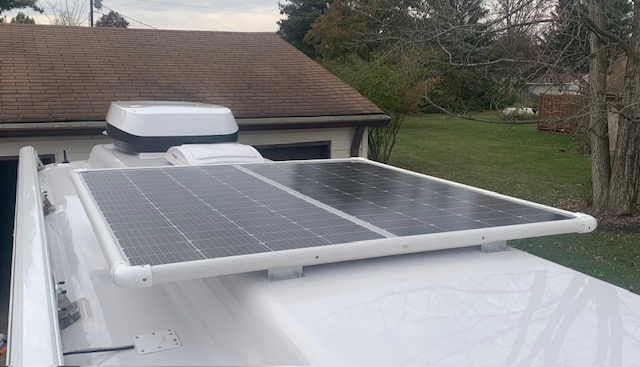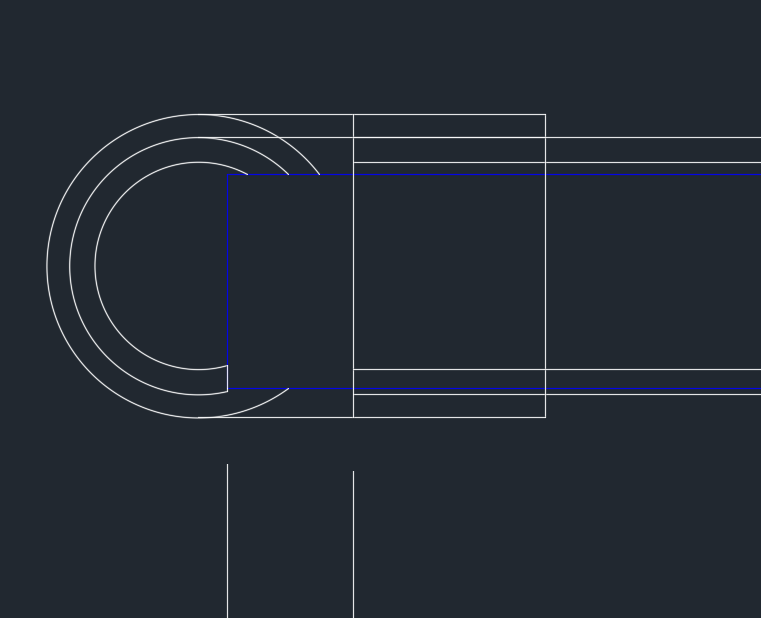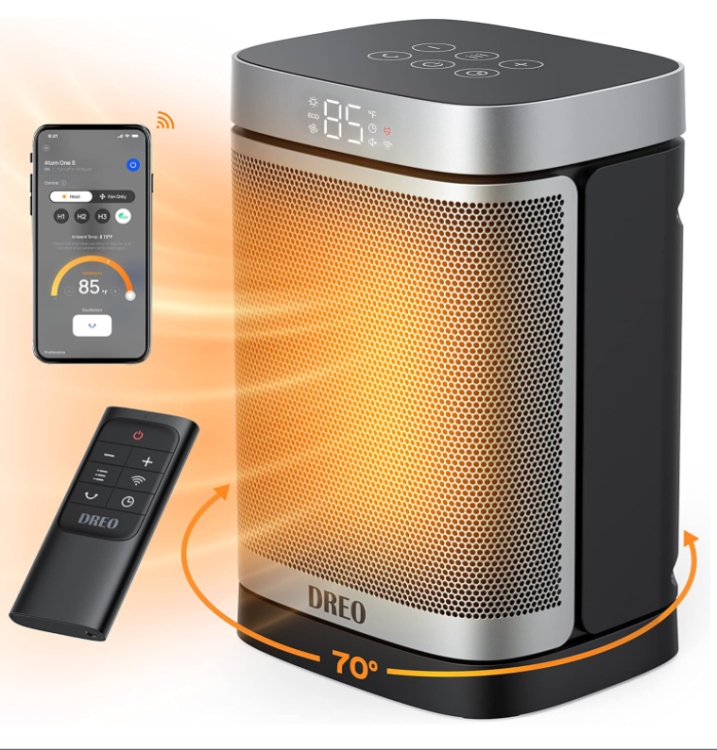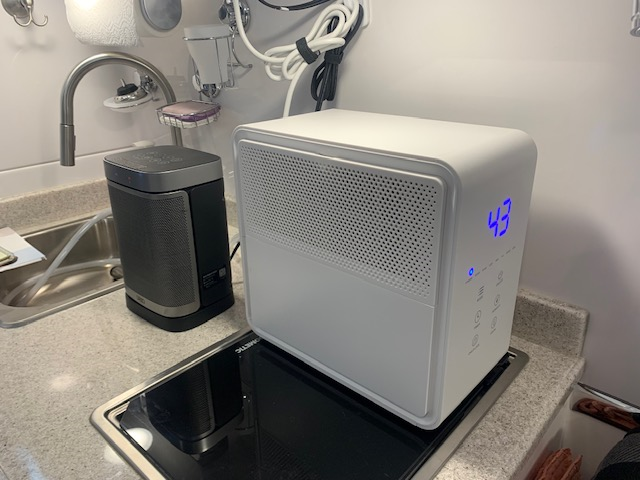-
Posts
434 -
Joined
-
Last visited
-
Days Won
14
Everything posted by Ollie-Haus
-
Along with a fresh wax job, that pvc frame made installing the caver very easy. Started at the back and unrolled towards the front. Then stood on the bumper and pulled the cover back and down until it was centered on the camper. It was so smooth and slippery the cover just glided into position.
-
Thanks John, and I appreciate the tip on preserving the integrity of the material. Per the link you provided I think I’ll paint the frame with a PVC furniture paint. Like any PVC you buy at the big box store, this has scuffs and stains on it so it’d look better painted anyway and would shield from the sun. Regarding the CAD software, I subscribe to AutoCad LT. I believe it’s around $400 if paid annually and there’s no contract. If you let it expire you retain your account and can renew at any time. You also have the option to pay monthly at a slightly higher cost if you only want to use it occasionally. I don’t know if it’s Mac compatible. There are other 2D and 3D software products out there that are cheaper but being an old dog I didn’t want to have to learn a new system. It works for my needs. Oh and you can transpose the image colors when printing.
-
In the interest of making the solar panels much more cover friendly, as in Calmark storage cover, and to just add a touch of finished look to the panels to match the color of the Oliver, I fabricated a permanent guard from 1-1/4" PVC pipe. It's notched out such that it just sits over the perimeter of the solar panels and fastens through the panel frames in 6 locations. No need to remove, but if the panels need service it takes about 10 minutes to remove in one assembled piece. I'm sure not everyone's cup of tea but I think it serves the purpose well which it's intended. I made a straight jig out of a 12"x60" piece of plywood with two 2x4's attached to hold the pvc rigid. I used a guide on the side of a circular saw to cut the pvc into the needed profile.
- 17 replies
-
- 10
-

-
I know this is an old thread, but I'd like to broaden the topic by asking if owners in cold climate conditions can comment on the heat produced by the inverter charger located under the streetside bed? We have the 3000 watt Xantrex in our 2023 Oliver, and I've noticed as @John E Davies mentioned earlier in the thread that the inverter produces significant heat in that compartment. I have a tracking WIFI temperature sensor in that space next to the outside shower box, and I'm wanting to see if the inverter has a significant effect on that space in cold temps. My thoughts being along the line of that being shared space with the outside shower connection, of course the inverter would only be producing significant heat while either charging the batteries or inverting battery power for 115v usage. If dry camping under battery/solar conditions, at night when the most inverter production is occurring, substantial heat would be produced during those critical hours. Just curious if anybody else has observed any effective benefit from this arrangement?
-
Some observations in freezing weather
Ollie-Haus replied to KenB's topic in Mechanical & Technical Tips
Love your scientific test methods! I'd love to help you in your analysis next time around! 😂 Good call on bringing the Ollie home to safety during deer season. I'd hate to find out the hard way what a stray high powered round does to the hull of an Oliver. The Ollie would be pretty invisible in the snow white countryside. Thanks for sharing your observations, actually pretty good information for us newbies. I've got tracking wifi thermometers in key locations in our Oliver to see how winter temps effect interior spaces. They wouldn't be much use in remote storage but in our driveway in Indiana they stay connected to the home WIFI for a permanent set of temp logs. Our first winter in storage will provide interesting data.- 1 reply
-
- 4
-

-
Thanks to my wife and our son, we are now Aeropress converts for life. We have a typical plug in induction water pot for any and all hot drink needs. Boils water faster than any other method. Using that to make tea, hot chocolate, hot toddies, you name it. Link: Induction Pot For coffee, the Aeropress is king. Once the water is boiling you can have a couple cups of perfect coffee in one minute each. No mess, simple clean up and fast. You pick your favorite coffee and grind. Very cheap and fast to operate. Stows away in the space of a coffee cup. link: Aeropress Video:
-
😆 I get what you're saying Steve, and to make it clear, this is an experiment first and foremost. I know I'll have the "climate" under control in the camper, but what I don't know is how much this will cost. 🙄 If it's ridiculous I'll simply revert to plan B. I do plan on keeping the camper just above freezing inside, we'll see how that works. Part of the experiment is on how well the little heater can keep up. Also how warm the basement spaces stay throughout the season. I have recording WIFI sensors in both sides and the battery compartment for tracking. Here's to throwing money out just for the fun of experimentation. 🍻
-
To directly address your question Steve, I would recommend closing the trailer up tight if you are using moisture absorbing packs. If you leave the vent open, whenever the humidity level outside rises higher than that in the camper, new moisture will be introduced into the camper which the desiccant will have to absorb. These packs only have so much capacity. If the camper is closed tight and the humidity level is brought down, the camper should remain dry after that until it's opened up again.
-
Ours will be sitting outside in Indiana. I'll be leaving the vents closed. I'm leaving a counter top dehumidifier running all winter in the Oliver. I don't think it's going to do much as when the temps drop below the 40 degree mark, it's readout on the front as well as a second hydrometer in the camper usually read a humidity level of less than 45%. I'm also leaving a small electric heater running all winter to keep the inside temps above freezing. This will allow the compressor style dehumidifier to run all winter without low temperature issues. It has a drain hose hanging in the galley sink so it won't have to be monitored regularly. Of course ours will remain connected to shore power throughout the winter storage. https://www.amazon.com/gp/product/B0BTBYT96F/ref=ppx_yo_dt_b_asin_title_o07_s00?ie=UTF8&psc=1 https://www.amazon.com/gp/product/B0BB725X9J/ref=ppx_yo_dt_b_asin_title_o00_s00?ie=UTF8&psc=1
-
Newbies taking the plunge - Are we missing anything
Ollie-Haus replied to Dennis and Melissa's topic in General Discussion
I haven't read through the entire thread, so I'm posting this risking it's already been mentioned. In a comment above you mentioned risking running out of water in exchange for longer stays in beautiful places. One thing I strongly encourage is considering a composting toilet based on your travel plans. 1. You will in effect double your fresh water capacity in a way because you will no longer be sending half your fresh water down the toilet. And if you can transition to sponge bathing you will use very little for that chore as well. We can easily go more than a week using most of our fresh water at the kitchen sink. 2. The whole drama of dump stations sort of fades into the background. We have yet to get in line at the dump station. You have many more options for dumping gray only, including that in most states you are allowed to dump gray water on the ground. You won't be able to at a park, but elsewhere it's fine. Some states encourage this practice to increase ground water around plants, etc. 3. The solids side of the composting toilet can last several weeks or months depending on your usage. We set up our composting toilet when we got the Oliver in May this year and just changed out the media for the first time this week while winterizing. We only use the camper toilet about half the time when at campgrounds so our usage is relatively low, but the system works perfectly and the whole waste disposal thing is very no drama for us. And we don't even own a so called stinky slinky. Our gray water is drained through a 3/4" garden hose dedicated for this purpose. The composting toilet just makes dry/extended camping a lot easier. BTW you can quickly switch to a standard toilet in the future with very little effort if you decide you want to go that route. -
Funny thing is I already have six apps to monitor systems on our Oliver and for the most part they are on the phone just in case. I really don't do very much with them other than take a look once in a while. Having the GX Cerbo sounds nice but the stuff I monkey with the most are already on the Truma control. So like the inverter/charger, it would really just be a replacement. I do love the Victron equipment and also wouldn't be surprised if Oliver continues to move that way in the future.
-
We're just six months in but to date the Xantrex 3000w inverter charger on board has been flawless. The Bluetooth app is easy to use and makes adjustments to the charge rate a simple process. If we have to plug into a 15 or 20 amp outlet the change only takes seconds on the app. I too was toying with the thought of "upgrading" to the Victron down the road but if the Xantrex continues satisfactorily it will stay in place until it dies. I would be interested though to compare the efficiency of each brand and model in the interest of wasting less power while inverting.
-
I like the idea of spot facing the copper bars where needed. I also like the flanged nuts. If you could spot face a large enough area to allow for the flanged nuts on the battery studs that wouldn't be a bad idea. Like your idea and I too would run a test period to find out where you stand now. Knowing your connections are improved, any other issues could be traced to their true source. Electrical troubleshooting can be challenging. Here's an example. We had a relatively new front load washing machine, you know, the kind that have a hundred bells and whistles. The kind the average Joe can't work on. Just out of warranty I got an error code on the screen that indicated a failed main control board. You're talking $300 plus for the part. I was doing a little research and stumbled onto a discussion about failures due to poor connections on the connector plugs on the boards. The solution was to pull all the connections, clean inside the tiny spring sockets, clean all the wire pins on the board side, use a micro screwdriver to bend the inside of the plug socket contacts to increase their "squeeze" on the wire pins when plugged in, and finally smear a thin layer of dielectric grease on the contact surfaces. Sounds like a lot but actually took 20-30 minutes to do to all the plugs. Reassembled and tested. All was well and no more failures for the 5 years following the "repair". The new owners are still using the same washer and dryer. Now when I'm trouble shooting electrical, especially the new stuff with built in diagnostics, I always start by checking all connections and improving as described above to eliminate false error codes.
-
Wow that is so much better than what you started with. I like your solutions far better than the previous owner's method. And the extremely clean and proper connections are very well thought out considering the objective and the budget considerations. I think a lot of folks tried to help, but as you stated it truly falls on the owner to make the hard choices. You obviously had a mental picture of where you needed to end up. Often when trouble shooting folks start making assumptions and end up way off course. I think you went about working the problem in a very logical and practical way. Now the question remains, have all your objectives been met? I'm guessing you are much closer. Well done. 👍
-
At 6'2" I hit my head regularly on the fan. Raising the level of the shower pan even a fraction is a no go for us.
-
Cold drizzle and gray skies in Indiana. Now waiting for the April event.
-
Newbies taking the plunge - Are we missing anything
Ollie-Haus replied to Dennis and Melissa's topic in General Discussion
Just a thought to consider. Upgrading to a solar package is not as easy as starting with one from the factory. This includes a factory upgrade after the camper is built. There are numerous components that must be changed besides the batteries, as well as adding the solar panel system. This question came up at the rally last spring as numerous owners of older models were considering upgrading to Lithium. Jason made it clear that the initial build was the best time to install a solar/lithium system, especially from a cost perspective. It can and has been done by several owners but the add on system is not very comparable to the factory system. We have the larger lithium package on our 2023 LE2 and it actually requires less maintenance attention than standard lead acid battery system. The lithium batteries have a much longer service life than the lead acid batteries as well. Just my thoughts. Either way you go, battery management becomes a part of your life owning a travel trailer. -
The cable lugs with the spacers have been address, but I have to say I was shocked, no pun intended, to see these kind of connections. This is grossly out of standard and a serious problem. It's hard to tell from the overhead photo, but it appears there may be additional spacers at other connections as well under the cable lugs. As was mentioned above, you need to have sparkling clean connections and all lugs should be stacked together against the lead base of the battery terminals, no spacers if possible. Any resistance at any and all of these connections will play havoc with your charging control system and it's efficiency. I firmly believe this could be a root cause that needs addressed before you trouble shoot other components downstream. I would systematically check/correct every connection in the system as a starting point. I wouldn't replace any component without verifying it's function first. Doing otherwise just introduces more variables to the problem, and of course adds undue cost.
-
As mentioned above, I have since got an additional active SIM card from the local TMobile store (unlimited data and $35 per month with auto pay) and have been using it in the trailer as a hot spot in a spare older phone with great success. I guess my next move is to install the SIM in the Cradle Point and see if I also experience success. Sounds like a plug and play no brainer. We'll see.
-
No 120 vac from outlets in Elite II.
Ollie-Haus replied to docron's topic in Mechanical & Technical Tips
As John D. said above, I would start at the back of the GFI plug and trace backwards for power. You obviously have a functioning 120v system, just no power beyond the GFI, which will effect all other outlets. Likely a loose connection or a bad GFI. GFI's are very prone to failure. If you can eliminate any other problem, meaning you have 120 volts to the wires connecting to the back of the GFI, than letting Oliver service know they will probably send you out and new GFI promptly. If you don't have power at the wires on the back of the GFI, you will need to check at the next connection back that those wires connect to until you find the loose connection. Best approach is to fill out a trouble ticket. This allows the chain of management at Oliver service to monitor the progress and problems/solutions found. Regarding Oliver not willing to troubleshoot the 120v system, it sounds like some confusion has occurred. They will not troubleshoot beyond the shore connection, but the absolutely will troubleshoot from the shore connection to the internal systems of the camper. -
It takes less than 10 minutes to drain. If you are on an uphill slope it drains quickly. I drain my gray water when we get home in most cases. My method is to back into my parking spot and then go back and set up my drain line and open the valve. Then I unhitch the camper raising the tongue a few inches higher than the ball. By the time I park the truck and get back to the camper it’s done draining. Probably five minutes. Depending on where you live, you can drain gray water on the ground, some areas recommend this.
-
I don't believe it hurts anything to run the pump while connected to city water. There is no change in the valve configuration so whether the pump just pulls from the fresh tank or facilitates the flow of city water makes little difference. Regarding the waste tank drain. We also have the composting toilet so before even coming home from picking up our Oliver, I installed the adaptor fitting to allow draining with a standard garden hose. That fitting is even sold in the Oliver accessory display at the showroom. I purchased a black 3/4" garden hose about 15' in length before delivery day and I leave it permanently attached to the sewer drain connection. I have a hose end cap on the other end to prevent leaking while traveling. Link: Adaptor
-
Wow Brian, so sad to hear of your mother's passing. We are on similar ground as my mother passed on July 13th. After loosing my younger brother this spring it has really taken the wind out of my sails. My prayer is for peace of mind and strength for you all going forward. Following that with a major engine failure is a real punch in the gut. I know there have been a few 7.3 failures but they are very rare. At least they are taking care of you. I hope to get 200k plus with no issues. I am considering extending my warranty though. Hopefully all will smooth out and joy will return. Glad you are all safe and well after all the events.
-
Welcome to the Oliver family and the forum! Steep learning curve those first few days using the Ollie. Just tested mine with the unit switch off and that is the code that popped up on the control panel when I tried to turn the water heater on inside. Not sure why they are saying to turn off the unit switch for travel. I would personally only turn this off for storage.
-
It's also easily removed and restored to original if ever desired. I do like the idea of a dimmer as well.













